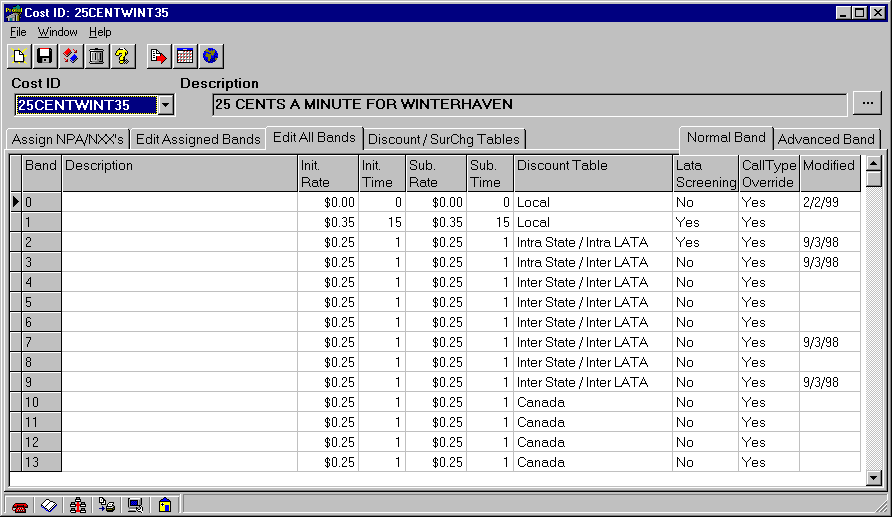Edit All Bands
A cost band is like a price tag that can be attached to calls going to an office code. The cost band specifies the rates and times of phone calls, from a local call to a call that spans the country. The Edit All Bands tab is found in the
Cost window.
To open the Cost window, click on the
Configuration button in either the Navigator or the Navbar and select Cost Records from the pull-down menu that appears. Click on the Edit All Bands tab.

All of the 137 bands appear in the third tab of the
Cost window, Edit All Bands. Bands 0 through 79 are user-configurable. Bands 80 through 137 are reserved for Special Purpose numbers.
Each cost band is listed in a table with the Init. Rate, Init. Time, Sub. Rate, Sub. Time, Discount Table, and Lata Screening. The initial rate and time determine how much will be charged for the first minute(s). An example of this is thirty-five cents for the first three minutes. The subsequent rate and time determine how much to charge for the minutes after the initial minutes. An example of this is twenty-five cents every fifteen minutes, after the initial time has passed. The Discount Table column displays what
Call Type the area code or office code is. The Call Type determines what the discounts, surcharges, or minimum costs are and determines what Call Processing specifics to use.
Lata Screening is used to screen dialed numbers for calls that are going to the sama Lata. Typically, this is used for calls that should go through the LEC (Local Exchange Carrier). When screening a call in this way, the payphone first looks in the Lata Screening column in the
Cost record. If there is a Yes for the band that the dialed number falls in, the payphone next looks in the Call Processing information. If the Lata Screening column here is also set to Yes for the Call Type, then the phone looks at the Route that was determined to be used for this call, and instead uses the route specified in the Alternate Splash Route box. The number in this box is looked up in the Route Assignments window, and that route is used instead. If either the Cost or the Call Processing windows has a No in the Lata Screening column, the call will be placed normally, using the route found in the Call Processing window (or the Cost window, if you have not yet Condensed Call Processing and Route Records).
Lata Screening cannot work concurrently with 0+ separation by Call Type.
Call Type Override is a toggle to choose between getting the remainder of the information from a table organized by
Call Type (which Discount / Surcharge Table type is assigned to the record) or from the end of the cost band. When the Override says Yes, then the first eight rows in the Call Processing window will be ignored, and Panorama will get this information from the columns following the Call Type Override column, in the Cost window. When Override is set to No, the cost band will look at the Call Type and then look in the Call Processing window, by this Call Type, for the remainder of the information.
The benefits of using the new system of classifying calls by Call Type comes with many advantages. Checking option 1A5 in the
Unassigned tab of the Options window tells the payphone to record the Call Type within the Call Detail Record. CDR with this information provide more information to the Call Accounting window and the Call Accounting Report. Also, when polling, CDR can be collected from the phone by Call Type (using the Collect CDR column in the Call Processing window). By not pulling unnecessary records from the phone, polling times are shortened, and money is saved. All of this depends upon the Cost recordís information. Assigning the proper discount table to a cost band tells the phone that a dialed number is a certain Call Type. Cost tables purchased from Protel or Protelís distributors come with this information.
Note: Recording and collecting CDR by Call Type is only available when using
Y2k compliant firmware. Also, a properly configured Cost record is necessary to classify a call by Call Type. Cost files obtained from Protel and Protelís distributors contain the necessary information to take advantage of this useful and money-saving feature.
Cost records imported from ExpressNet will have the Call Type Override set to Yes. See the topic
Discount Table Translation for information on how the Call Type names have changed from ExpressNet to Panorama. Please refer to the Help topic Condense Call Processing and Route Records for detailed instructions on cleaning up records after importing them from ExpressNet. Cost files imported from other sources, as when updating files, will be imported with the Call Type Override set to No. This is a graduated move to using the information located in the Call Processing window, by Call Type, instead of using the information in the Cost window, by cost band. Refer to the Help information about the Call Processing window for information on Key Pad Activity, Fraud Deterrent, Route #, Route ID, Answer Recognition, Capture Digits, Collect CDR, and the Drug Window.
